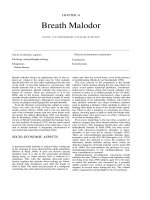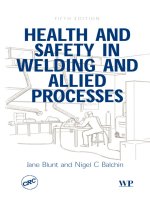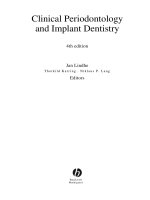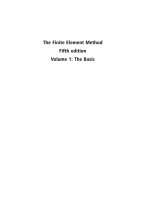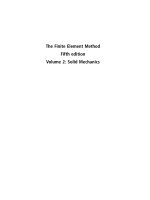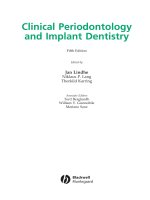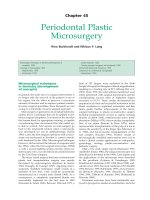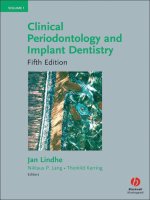Clinical Periodontology and Implant Dentistry Fifth Edition: Volume 1 BASIC CONCEPTS docx
Bạn đang xem bản rút gọn của tài liệu. Xem và tải ngay bản đầy đủ của tài liệu tại đây (40.63 MB, 592 trang )
Clinical Periodontology
and Implant Dentistry
Fifth Edition
Edited by
Jan Lindhe
Niklaus P. Lang
Thorkild Karring
Associate Editors
Tord Berglundh
William V. Giannobile
Mariano Sanz
Volume 1
BASIC CONCEPTS
Edited by
Jan Lindhe
Niklaus P. Lang
Thorkild Karring
© 2008 by Blackwell Munksgaard, a Blackwell Publishing company
Blackwell Publishing editorial offi ces:
Blackwell Publishing Ltd, 9600 Garsington Road, Oxford OX4 2DQ, UK
Tel: +44 (0)1865 776868
Blackwell Publishing Professional, 2121 State Avenue, Ames, Iowa 50014-8300, USA
Tel: +1 515 292 0140
Blackwell Publishing Asia Pty Ltd, 550 Swanston Street, Carlton, Victoria 3053, Australia
Tel: +61 (0)3 8359 1011
The right of the Author to be identifi ed as the Author of this Work has been asserted in accordance
with the Copyright, Designs and Patents Act 1988.
All rights reserved. No part of this publication may be reproduced, stored in a retrieval system, or
transmitted, in any form or by any means, electronic, mechanical, photocopying, recording or
otherwise, except as permitted by the UK Copyright, Designs and Patents Act 1988, without the prior
permission of the publisher.
Designations used by companies to distinguish their products are often claimed as trademarks. All
brand names and product names used in this book are trade names, service marks, trademarks or
registered trademarks of their respective owners. The Publisher is not associated with any product or
vendor mentioned in this book.
This publication is designed to provide accurate and authoritative information in regard to the subject
matter covered. It is sold on the understanding that the Publisher is not engaged in rendering
professional services. If professional advice or other expert assistance is required, the services of a
competent professional should be sought.
First published 1983 by Munksgaard
Second edition published 1989
Third edition published 1997
Fourth edition published by Blackwell Munksgaard 2003
Reprinted 2003, 2005, 2006
Fifth edition 2008 by Blackwell Publishing Ltd
ISBN: 978-1-4051-6099-5
Library of Congress Cataloging-in-Publication Data
Clinical periodontology and implant dentistry / edited by Jan Lindhe,
Niklaus P. Lang, Thorkild Karring. — 5th ed.
p. ; cm.
Includes bibliographical references and index.
ISBN: 978-1-4051-6099-5 (hardback : alk. paper)
1. Periodontics. 2. Periodontal disease. 3. Dental implants. I. Lindhe, Jan.
II. Lang, Niklaus Peter. III. Karring, Thorkild.
[DNLM: 1. Periodontal Diseases. 2. Dental Implantation. 3. Dental Implants.
WU 240 C6415 2008]
RK361.C54 2008
617.6′32—dc22
2007037124
A catalogue record for this title is available from the British Library
Set in 9.5/12 pt Palatino by SNP Best-set Typesetter Ltd., Hong Kong
Printed and bound in Singapore by C.O.S. Printers Pte Ltd
The publisher’s policy is to use permanent paper from mills that operate a sustainable forestry policy,
and which has been manufactured from pulp processed using acid-free and elementary chlorine-free
practices. Furthermore, the publisher ensures that the text paper and cover board used have met
acceptable environmental accreditation standards.
For further information on Blackwell Publishing, visit our website:
www.blackwellmunksgaard.com
Contents
Contributors, xvii
Preface, xxi
Volume 1: BASIC CONCEPTS
Editors: Jan Lindhe, Niklaus P. Lang, and Thorkild Karring
Part 1: Anatomy
1 The Anatomy of Periodontal Tissues, 3
Jan Lindhe, Thorkild Karring, and Maurício Araújo
Introduction, 3
Gingiva, 5
Macroscopic anatomy, 5
Microscopic anatomy, 8
Periodontal ligament, 27
Root cementum, 31
Alveolar bone, 34
Blood supply of the periodontium, 43
Lymphatic system of the periodontium, 47
Nerves of the periodontium, 48
2 The Edentulous Alveolar Ridge, 50
Maurício Araújo and Jan Lindhe
Clinical considerations, 50
Remaining bone in the edentulous ridge, 52
Classifi cation of remaining bone, 53
Topography of the alveolar process, 53
Alterations of the alveolar process following tooth
extraction, 54
Intra-alveolar processes, 54
Extra-alveolar processes, 62
Topography of the edentulous ridge, 66
3 The Mucosa at Teeth and Implants, 69
Jan Lindhe, Jan L. Wennström, and
Tord Berglundh
The gingiva, 69
Biologic width, 69
Dimensions of the buccal tissue, 69
Dimensions of the interdental papilla, 71
The peri-implant mucosa, 71
Biologic width, 72
Quality, 76
Vascular supply, 77
Probing gingiva and peri-implant mucosa, 78
Dimensions of the buccal soft tissue at implants, 80
Dimensions of the papilla between teeth and implants,
81
Dimensions of the “papilla” between adjacent
implants, 82
4 Bone as a Tissue, 86
William V. Giannobile, Hector F. Rios, and
Niklaus P. Lang
Basic bone biology, 86
Bone cells, 86
Modeling and remodeling, 87
Growth factors and alveolar bone healing, 88
Local and systemic factors affecting bone volume and
healing, 89
Metabolic disorders affecting bone metabolism, 89
Bone healing, 93
Bone grafting, 93
Human experimental studies on alveolar bone
repair, 94
5 Osseointegration, 99
Jan Lindhe, Tord Berglundh, and Niklaus P. Lang
The edentulous site, 99
Osseointegration, 99
Implant installation 99
Tissue injury, 99
Wound healing, 100
Cutting and non-cutting implants, 100
The process of osseointegration, 103
6 Periodontal Tactile Perception and
Peri-implant Osseoperception, 108
Reinhilde Jacobs
Introduction, 108
Neurophysiological background, 109
Afferent nerve fi bres and receptors, 109
Trigeminal neurophysiology, 109
Trigeminal neurosensory pathway, 109
Neurovascularization of the jaw bones, 109
Mandibular neuroanatomy, 110
Maxillary neuroanatomy, 111
Periodontal innervation, 112
Testing tactile function, 113
Neurophysiological assessment, 113
Psychophysical assessment, 114
Periodontal tactile function, 115
Active threshold determination, 115
Passive threshold determination, 115
Infl uence of dental status on tactile function, 116
vi Contents
Activation of oral mechanoreceptors during oral
tactile function, 117
Functional testing of the oral somatosensory
system, 117
Oral stereognosis, 118
Infl uence of dental status on stereognostic
ability, 118
Other compromising factors for oral stereognosis,
118
Receptor activation during oral stereognosis,
119
From periodontal tactile function to peri-implant
osseoperception, 119
Tooth extraction considered as sensory
amputation, 119
Histological background of peri-implant
osseoperception, 120
Cortical plasticity after tooth extraction, 121
From osseoperception to implant-mediated
sensory motor interactions, 121
Clinical implications of implant-deviated sensory
motor interaction, 122
Conclusions, 122
Part 2: Epidemiology
7 Epidemiology of Periodontal Diseases, 129
Panos N. Papapanou and Jan Lindhe
Introduction, 129
Methodological issues, 129
Examination methods – index systems, 129
Critical evaluation, 131
Prevalence of periodontal diseases, 133
Introduction, 133
Periodontitis in adults, 133
Periodontal disease in children and
adolescents, 138
Periodontitis and tooth loss, 141
Risk factors for periodontitis, 141
Introduction – defi nitions, 141
Non-modifi able background factors, 143
Environmental, acquired, and behavioral
factors, 145
Periodontal infections and risk for systemic disease,
156
Atherosclerosis – cardiovascular/cerebrovascular
disease, 156
Pregnancy complications, 159
Diabetes mellitus, 162
Part 3: Microbiology
8 Oral Biofi lms and Calculus, 183
Niklaus P. Lang, Andrea Mombelli, and
Rolf Attström
Microbial considerations, 183
General introduction to plaque formation, 184
Dental plaque as a biofi lm, 187
Structure of dental plaque, 187
Supragingival plaque, 187
Subgingival plaque, 191
Peri-implant plaque, 196
Dental calculus, 197
Clinical appearance, distribution, and clinical
diagnosis, 197
Attachment to tooth surfaces and implants, 200
Mineralization, composition, and structure, 201
Clinical implications, 202
9 Periodontal Infections, 207
Sigmund S. Socransky and Anne D. Haffajee
Introduction, 207
Similarities of periodontal diseases to other
infectious diseases, 207
Unique features of periodontal infections, 208
Historical perspective, 209
The early search, 209
The decline of interest in microorganisms, 211
Non-specifi c plaque hypothesis, 211
Mixed anaerobic infections, 211
Return to specifi city in microbial etiology of
periodontal diseases, 212
Changing concepts of the microbial etiology of
periodontal diseases, 212
Current suspected pathogens of destructive
periodontal diseases, 213
Criteria for defi ning periodontal pathogens, 213
Periodontal pathogens, 213
Mixed infections, 225
The nature of dental plaque – the biofi lm way of life,
226
The nature of biofi lms, 226
Properties of biofi lms, 227
Techniques for the detection and enumeration of
bacteria in oral biofi lm samples, 229
The oral biofi lms that lead to periodontal
diseases, 229
Microbial complexes, 231
Factors that affect the composition of subgingival
biofi lms, 232
Microbial composition of supra- and subgingival
biofi lms, 238
Development of supra- and subgingival biofi lms,
239
Prerequisites for periodontal disease initiation and
progression, 242
The virulent periodontal pathogen, 243
The local environment, 243
Host susceptibility, 244
Mechanisms of pathogenicity, 245
Essential factors for colonization of a subgingival
species, 245
Effect of therapy on subgingival biofi lms, 249
10 Peri-implant Infections, 268
Ricardo P. Teles, Anne D. Haffajee, and
Sigmund S. Socransky
Introduction, 268
Early biofi lm development on implant surfaces, 268
Time of implant exposure and climax community
complexity, 271
The microbiota on implants in edentulous subjects, 273
The microbiota on implants in partially edentulous
subjects, 275
The microbiota on implants in subjects with a history
of periodontal disease, 276
The microbiota of peri-implantitis sites, 277
Contents vii
Part 4: Host–Parasite Interactions
11 Pathogenesis of Periodontitis, 285
Denis F. Kinane, Tord Berglundh, and Jan Lindhe
Introduction, 285
Clinically healthy gingiva, 286
Gingival infl ammation, 287
Histopathological features of gingivitis, 287
Different lesions in gingivitis/periodontitis, 289
The initial lesion, 289
The early lesion, 289
The established lesion, 290
The advanced lesion, 292
Host–parasite interactions, 294
Microbial virulence factors, 294
Host defense processes, 295
Important aspects of host defense processes, 295
The innate defense systems, 297
The immune or adaptive defense system, 299
12 Modifying Factors, 307
Richard Palmer and Mena Soory
Diabetes mellitus, 307
Type 1 and type 2 diabetes mellitus, 307
Clinical symptoms, 308
Oral and periodontal effects, 308
Association of periodontal infection and diabetic
control, 309
Modifi cation of the host–bacteria relationship in
diabetes, 310
Periodontal treatment, 311
Puberty, pregnancy, and the menopause, 312
Puberty and menstruation, 312
Pregnancy, 312
Menopause and osteoporosis, 314
Hormonal contraceptives, 316
Tobacco smoking, 316
Periodontal disease in smokers, 317
Modifi cation of the host–bacteria relationship in
smoking, 319
Smoking cessation, 322
13 Susceptibility, 328
Bruno G. Loos, Ubele van der Velden, and
Marja L. Laine
Introduction, 328
Evidence for the role of genetics in periodontitis, 331
Heritability of aggressive periodontitis (early
onset periodontitis), 331
Heritability of chronic periodontitis (adult
periodontitis), 332
A gene mutation with major effect on human disease
and its association with periodontitis, 332
Disease-modifying genes in relation to periodontitis,
333
IL-1 and TNF-α gene polymorphisms, 334
FcγR gene polymorphisms, 336
Gene polymorphisms in the innate immunity
receptors, 338
Vitamin D receptor gene polymorphisms, 338
IL-10 gene polymorphisms, 339
Miscellaneous gene polymorphisms, 340
Disease-modifying genes in relation to implant failures
and peri-implantitis, 340
Early failures in implant dentistry, 341
Late failures in implant dentistry, 342
Conclusions and future developments, 342
Part 5: Trauma from Occlusion
14 Trauma from Occlusion: Periodontal Tissues,
349
Jan Lindhe, Sture Nyman, and Ingvar Ericsson
Defi nition and terminology, 349
Trauma from occlusion and plaque-associated
periodontal disease, 349
Analysis of human autopsy material, 350
Clinical trials, 352
Animal experiments, 353
15 Trauma from Occlusion: Peri-implant Tissues,
363
Niklaus P. Lang and Tord Berglundh
Introduction, 363
Orthodontic loading and alveolar bone, 363
Bone reactions to functional loading, 365
Excessive occlusal load on implants, 365
Static and cyclic loads on implants, 366
Load and loss of osseointegration, 368
Masticatory occlusal forces on implants, 369
Tooth–implant supported reconstructions, 370
Part 6: Periodontal Pathology
16 Non-Plaque Induced Infl ammatory Gingival
Lesions, 377
Palle Holmstrup
Gingival diseases of specifi c bacterial origin, 377
Gingival diseases of viral origin, 378
Herpes virus infections, 378
Gingival diseases of fungal origin, 380
Candidosis, 380
Linear gingival erythema, 381
Histoplasmosis, 382
Gingival lesions of genetic origin, 383
Hereditary gingival fi bromatosis, 383
Gingival diseases of systemic origin, 384
Mucocutaneous disorders, 384
Allergic reactions, 392
Other gingival manifestations of systemic
conditions, 394
Traumatic lesions, 396
Chemical injury, 396
Physical injury, 396
Thermal injury, 397
Foreign body reactions, 398
17 Plaque-Induced Gingival Diseases, 405
Angelo Mariotti
Classifi cation criteria for gingival diseases, 405
Plaque-induced gingivitis, 407
Gingival diseases associated with endogenous
hormones, 408
Puberty-associated gingivitis, 408
Menstrual cycle-associated gingivitis, 409
Pregnancy-associated gingival diseases, 409
Gingival diseases associated with medications, 410
Drug-infl uenced gingival enlargement, 410
viii Contents
Oral contraceptive-associated gingivitis, 411
Gingival diseases associated with systemic diseases,
411
Diabetes mellitus-associated gingivitis, 411
Leukemia-associated gingivitis, 411
Linear gingival erythema, 412
Gingival diseases associated with malnutrition, 412
Gingival diseases associated with heredity, 413
Gingival diseases associated with ulcerative lesions,
413
Treatment of plaque-induced gingival diseases,
414
The signifi cance of gingivitis, 414
18 Chronic Periodontitis, 420
Denis F. Kinane, Jan Lindhe, and
Leonardo Trombelli
Clinical features of chronic periodontitis, 420
Overall characteristics of chronic periodontitis, 420
Gingivitis as a risk for chronic periodontitis, 422
Susceptibility to chronic periodontitis, 422
Prevalence of chronic periodontitis, 423
Progression of chronic periodontitis, 423
Risk factors for chronic periodontitis, 424
Bacterial plaque, 424
Age, 424
Smoking, 424
Systemic disease, 424
Stress, 425
Genetics, 426
Scientifi c basis for treatment of chronic periodontitis,
426
19 Aggressive Periodontitis, 428
Maurizio S. Tonetti and Andrea Mombelli
Classifi cation and clinical syndromes, 429
Epidemiology, 431
Primary dentition, 432
Permanent dentition, 432
Screening, 433
Etiology and pathogenesis, 437
Bacterial etiology, 437
Genetic aspects of host susceptibility, 441
Environmental aspects of host susceptibility, 445
Current concepts, 445
Diagnosis, 445
Clinical diagnosis, 445
Microbiologic diagnosis, 448
Evaluation of host defenses, 448
Genetic diagnosis, 449
Principles of therapeutic intervention, 449
Elimination or suppression of the pathogenic
fl ora, 449
20 Necrotizing Periodontal Disease, 459
Palle Holmstrup and Jytte Westergaard
Nomenclature, 459
Prevalence, 460
Clinical characteristics, 460
Development of lesions, 460
Interproximal craters, 461
Sequestrum formation, 462
Involvement of alveolar mucosa, 462
Swelling of lymph nodes, 463
Fever and malaise, 463
Oral hygiene, 463
Acute and recurrent/chronic forms of necrotizing
gingivitis and periodontitis, 463
Diagnosis, 464
Differential diagnosis, 464
Histopathology, 465
Microbiology, 466
Microorganisms isolated from necrotizing lesions,
466
Pathogenic potential of microorganisms, 466
Host response and predisposing factors, 468
Systemic diseases, 468
Poor oral hygiene, pre-existing gingivitis, and
history of previous NPD, 469
Psychologic stress and inadequate sleep, 469
Smoking and alcohol use, 470
Caucasian background, 470
Young age, 470
Treatment, 470
Acute phase treatment, 470
Maintenance phase treatment, 472
21 Periodontal Disease as a Risk for Systemic
Disease, 475
Ray C. Williams and David W. Paquette
Early twentieth century concepts, 475
Periodontitis as a risk for cardiovascular disease, 476
Biologic rationale, 479
Periodontitis as a risk for adverse pregnancy
outcomes, 480
Association of periodontal disease and pre-
eclampsia, 486
Periodontitis as a risk for diabetic complications, 486
Periodontitis as a risk for respiratory infections, 488
Effects of treatment of periodontitis on systemic
diseases, 489
22 The Periodontal Abscess, 496
Mariano Sanz, David Herrera, and
Arie J. van Winkelhoff
Introduction, 496
Classifi cation, 496
Prevalence, 497
Pathogenesis and histopathology, 497
Microbiology, 498
Diagnosis, 498
Differential diagnosis, 499
Treatment, 500
Complications, 501
Tooth loss, 501
Dissemination of the infection, 502
23 Lesions of Endodontic Origin, 504
Gunnar Bergenholtz and Domenico Ricucci
Introduction, 504
Disease processes of the dental pulp, 504
Causes, 504
Progression and dynamic events, 505
Accessory canals, 507
Periodontal tissue lesions to root canal infection,
510
Effects of periodontal disease and periodontal therapy
on the condition of the pulp, 516
Infl uences of periodontal disease, 516
Infl uence of periodontal treatment measures on
the pulp, 518
Root dentin hypersensitivity, 518
Contents ix
Part 7: Peri-implant Pathology
24 Peri-implant Mucositis and Peri-implantitis,
529
Tord Berglundh, Jan Lindhe, and Niklaus P. Lang
Defi nitions, 529
Ridge mucosa, 529
Peri-implant mucosa, 529
Peri-implant mucositis, 530
Clinical features, 530
Prevalence, 530
Histopathology, 530
Peri-implantitis, 532
Clinical features, 532
Prevalence, 532
Histopathology, 534
Part 8: Tissue Regeneration
25 Concepts in Periodontal Tissue Regeneration,
541
Thorkild Karring and Jan Lindhe
Introduction, 541
Regenerative periodontal surgery, 542
Periodontal wound healing, 542
Regenerative capacity of bone cells, 547
Regenerative capacity of gingival connective
tissue cells, 547
Regenerative capacity of periodontal ligament
cells, 548
Role of epithelium in periodontal wound healing,
549
Root resorption, 550
Regenerative concepts, 550
Grafting procedures, 551
Root surface biomodifi cation, 557
Growth regulatory factors for periodontal
regeneration, 559
Guided tissue regeneration (GTR), 559
Assessment of periodontal regeneration, 561
Periodontal probing, 561
Radiographic analysis and re-entry operations,
562
Histologic methods, 562
Index, i1
Volume 2: CLINICAL CONCEPTS
Editors: Niklaus P. Lang and Jan Lindhe
Part 9: Examination Protocols
26 Examination of Patients with Periodontal
Diseases, 573
Giovanni E. Salvi, Jan Lindhe, and Niklaus P. Lang
History of periodontal patients, 573
Chief complaint and expectations, 573
Social and family history, 573
Dental history, 573
Oral hygiene habits, 573
Smoking history, 574
Medical history and medications, 574
Signs and symptoms of periodontal diseases, 574
The gingiva, 574
The periodontal ligament and the root cementum,
577
The alveolar bone, 583
Diagnosis of periodontal lesions, 583
Oral hygiene status, 584
Additional dental examinations, 585
27 Examination of the Candidate for Implant
Therapy, 587
Hans-Peter Weber, Daniel Buser, and Urs C. Belser
Dental implants in periodontally compromised
patients, 587
Patient history, 590
Chief complaint and expectations, 590
Social and family history, 590
Dental history, 590
Motivation and compliance, 591
Habits, 591
Medical history and medications, 591
Local examination, 591
Extraoral, 591
General intraoral examination, 592
Radiographic examination, 592
Implant-specifi c intraoral examination, 592
Patient-specifi c risk assessment, 597
Risk assessment for sites without esthetic
implications, 597
Risk assessment for sites with esthetic
implications, 597
28 Radiographic Examination of the Implant
Patient, 600
Hans-Göran Gröndahl and Kerstin Gröndahl
Introduction, 600
Radiographic examination for implant planning
purposes – general aspects, 601
The clinical vs. the radiologic examination, 601
What is the necessary radiographic information?,
601
Radiographic methods for obtaining the
information required for implant planning, 603
Radiographic examination for implant planning
purposes – upper jaw examination, 607
Radiographic examination for implant planning
purposes – lower jaw examination, 610
Radiographic monitoring of implant treatment, 614
Radiation detectors for intraoral radiography, 618
Image-guided surgery, 621
29 Examination of Patients with Implant-
Supported Restorations, 623
Urs Brägger
Identifi cation of the presence of implants and implant
systems, 623
Screening, 623
Implant pass, 623
x Contents
Questionnaire for new patients, 625
Anamnestic information from patients on
maintenance, 625
The development of implant recognition software,
625
Clinical inspection and examination, 625
Characteristics of implant-supported restorations,
625
Characteristics of prosthetic components and
components of implant systems, 626
Technical failures/complications, 626
Function, 628
Functional analysis, 628
Articulation, phonetics, 628
Implant, 628
Clinical test of mobility, 629
Electronic tools to assess the quality of
osseointegration, 629
Bacterial deposits, 629
Soft tissues, 629
Mucosa, 629
Palpation/sensitivity, 629
Recession, pocket probing depth, probing
attachment level, bleeding on probing, 629
Esthetics, 630
Papillae, interdental space and type of mucosa,
630
Condition of adjacent teeth, 631
Color shades, 632
30 Risk Assessment of the Implant Patient, 634
Gary C. Armitage and Tord Lundgren
Principles of risk assessment, 634
Clinical information required for risk assessment,
636
Technical procedures to help minimize risk, 636
Local risk factors and conditions, 637
Presence of ongoing oral infections, 637
Systemic risk factors, 639
Age, 639
Smoking, 640
Medication history, 640
Immunosuppression, 642
History of radiation therapy to the jaws, 642
Diabetes mellitus, 642
Metabolic bone disease, 643
Connective tissue and autoimmune disorders, 643
Xerostomia, 644
Hematologic and lymphoreticular disorders, 644
Genetic traits and disorders, 644
Importance of behavioral considerations in risk
assessment, 645
Dental history of compliance behaviors, 645
Substance use/abuse, 645
Psychiatric/psychological issues, 645
Lack of understanding or communication, 645
Patient’s expectations, 646
Interest and commitment to post-treatment care and
maintenance program, 646
Part 10: Treatment Planning Protocols
31 Treatment Planning of Patients with
Periodontal Diseases, 655
Giovanni E. Salvi, Jan Lindhe, and Niklaus P. Lang
Screening for periodontal disease, 656
Basic periodontal examination, 656
Diagnosis, 657
Treatment planning, 658
Initial treatment plan, 658
Pre-therapeutic single tooth prognosis, 660
Case presentation, 660
Case report, 667
Patient S.K. (male, 35 years old), 667
32 Treatment Planning for Implant Therapy in
the Periodontally Compromised Patient, 675
Jan L. Wennström and Niklaus P. Lang
Prognosis of implant therapy in the periodontally
compromised patient, 675
Strategies in treatment planning, 676
Treatment decisions – case reports, 676
Posterior segments, 676
Tooth versus implant, 679
Aggressive periodontitis, 680
Furcation problems, 682
Single-tooth problem in the esthetic zone, 683
33 Systemic Phase of Therapy, 687
Niklaus P. Lang and Hans-Rudolf Baur
Introduction, 687
Protection of the dental team and other patients
against infectious diseases, 687
Protection of the patient’s health, 688
Prevention of complications, 688
Infection, specifi cally bacterial endocarditis, 688
Bleeding, 689
Cardiovascular incidents, 690
Allergic reactions and drug interactions, 690
Systemic diseases, disorders or conditions infl uencing
pathogenesis and healing potential, 690
Control of anxiety and pain, 690
Smoking counseling, 691
Part 11: Initial Periodontal Therapy
(Infection Control)
34 Motivational Interviewing, 695
Christoph A. Ramseier, Delwyn Catley,
Susan Krigel, and Robert A. Bagramian
The importance of behavioral change counseling in
periodontal care, 695
Development of motivational interviewing, 696
History of motivational interviewing, 697
What is motivational interviewing?, 697
Evidence for motivational interviewing, 697
Implementation of motivational interviewing into the
periodontal treatment plan, 698
Key principles of motivational interviewing, 698
Basic communication skills, 698
Giving advice, 700
Case examples for oral hygiene motivation, 700
Oral hygiene motivation 1, 700
Oral hygiene motivation 2, 701
Case example for tobacco use cessation, 702
35 Mechanical Supragingival Plaque Control,
705
Fridus van der Weijden, José J. Echeverría,
Mariano Sanz, and Jan Lindhe
Contents xi
Importance of supragingival plaque removal, 705
Self-performed plaque control, 706
Brushing, 706
Interdental cleaning, 714
Adjunctive aids, 717
Side effects, 718
Importance of instruction and motivation in
mechanical plaque control, 719
36 Chemical Supragingival Plaque Control, 734
Martin Addy and John Moran
Classifi cation and terminology of agents, 734
The concept of chemical supragingival plaque control,
735
Supragingival plaque control, 736
Chemical supragingival plaque control, 737
Rationale for chemical supragingival plaque
control, 738
Approaches to chemical supragingival plaque
control, 739
Vehicles for the delivery of chemical agents, 740
Chemical plaque control agents, 742
Systemic antimicrobials including antibiotics, 743
Enzymes, 744
Bisbiguanide antiseptics, 744
Quaternary ammonium compounds, 744
Phenols and essential oils, 745
Natural products, 745
Fluorides, 746
Metal salts, 746
Oxygenating agents, 746
Detergents, 746
Amine alcohols, 746
Salifl uor, 747
Acidifi ed sodium chlorite, 747
Other antiseptics, 747
Chlorhexidine, 748
Toxicology, safety, and side effects, 748
Chlorhexidine staining, 749
Mechanism of action, 750
Chlorhexidine products, 750
Clinical uses of chlorhexidine, 751
Evaluation of chemical agents and products, 754
Studies in vitro, 755
Study methods in vitro, 755
Clinical trial design considerations, 757
37 Non-surgical Therapy, 766
Noel Claffey and Ioannis Polyzois
Introduction, 766
Detection and removal of dental calculus, 766
Methods used for non-surgical root surface
debridement, 768
Hand instrumentation, 768
Sonic and ultrasonic scalers, 770
Reciprocating instruments, 770
Ablative laser therapy, 771
Choice of debridement method, 771
The infl uence of mechanical debridement on
subgingival biofi lms, 772
Implication of furcation involvement, 773
Pain and discomfort following non-surgical therapy,
773
Re-evaluation, 774
Interpretation of probing measurements at
re-evaluation, 774
Average changes in measurements due to non-
surgical therapy, 775
Interpretation of longitudinal changes at
individual sites, 775
Prediction of outcome and evaluation of treatment, 775
Full-mouth disinfection, 776
Part 12: Additional Therapy
38 Periodontal Surgery: Access Therapy, 783
Jan L. Wennström, Lars Heijl, and Jan Lindhe
Introduction, 783
Techniques in periodontal pocket surgery, 783
Gingivectomy procedures, 784
Flap procedures, 786
Regenerative procedures, 793
Distal wedge procedures, 794
Osseous surgery, 795
Osteoplasty, 796
Ostectomy, 796
General guidelines for periodontal surgery, 797
Objectives of surgical treatment, 797
Indications for surgical treatment, 797
Contraindications for periodontal surgery, 799
Local anesthesia in periodontal surgery, 800
Instruments used in periodontal surgery, 802
Selection of surgical technique, 805
Root surface instrumentation, 808
Root surface conditioning/biomodifi cation, 808
Suturing, 808
Periodontal dressings, 811
Post-operative pain control, 812
Post-surgical care, 812
Outcome of surgical periodontal therapy, 812
Healing following surgical pocket therapy, 812
Clinical outcome of surgical access therapy in
comparison to non-surgical therapy, 814
39 Treatment of Furcation-Involved Teeth, 823
Gianfranco Carnevale, Roberto Pontoriero, and
Jan Lindhe
Terminology, 823
Anatomy, 824
Maxillary molars, 824
Maxillary premolars, 825
Mandibular molars, 825
Other teeth, 826
Diagnosis, 826
Probing, 828
Radiographs, 828
Differential diagnosis, 829
Trauma from occlusion, 829
Therapy, 830
Scaling and root planing, 830
Furcation plasty, 830
Tunnel preparation, 832
Root separation and resection (RSR), 832
Regeneration of furcation defects, 840
Extraction, 843
Prognosis, 843
40 Endodontics and Periodontics, 848
Gunnar Bergenholtz and Gunnar Hasselgren
Introduction, 848
xii Contents
Infectious processes in the periodontium of endodontic
origin, 849
General features, 849
Clinical presentations, 850
Distinguishing lesions of endodontic origin from
periodontitis, 851
Endo–perio lesions – diagnosis and treatment
aspects, 856
Endodontic treatments and periodontal lesions,
858
Iatrogenic root perforations, 858
Vertical root fractures, 859
Mechanisms, 860
Incidence, 861
Clinical expressions, 861
Diagnosis, 862
Treatment considerations, 863
External root resorptions, 865
Mechanisms of hard tissue resorption in general,
865
Clinical presentations and identifi cation, 866
Different forms, 866
41 Treatment of Peri-implant Lesions, 875
Tord Berglundh, Niklaus P. Lang, and Jan Lindhe
Introduction, 875
The diagnostic process, 875
Treatment strategies, 875
Resolution of peri-implantitis lesions, 877
Cumulative Interceptive Supportive Therapy (CIST),
878
Preventive and therapeutic strategies, 878
Mechanical debridement; CIST protocol A, 878
Antiseptic therapy; CIST protocol A+B, 878
Antibiotic therapy; CIST protocol A+B+C, 879
Regenerative or resective therapy; CIST protocol
A+B+C+D, 880
42 Antibiotics in Periodontal Therapy, 882
Andrea Mombelli
Principles of antibiotic therapy, 882
The limitations of mechanical therapy: can
antimicrobial agents help?, 882
Specifi c characteristics of the periodontal
infection, 883
Drug delivery routes, 884
Evaluation of antibiotics for periodontal therapy, 886
Systemic antimicrobial therapy in clinical trials,
888
Systemic antibiotics in clinical practice, 889
Local antimicrobial therapy in clinical trials, 890
Local antibiotics in clinical practice, 893
Overall conclusion, 893
Part 13: Reconstructive Therapy
43 Regenerative Periodontal Therapy, 901
Pierpaolo Cortellini and Maurizio S. Tonetti
Introduction, 901
Classifi cation and diagnosis of periodontal osseous
defects, 901
Clinical indications, 903
Long-term effects and benefi ts of regeneration, 903
Evidence for clinical effi cacy and effectiveness, 905
Patient and defect prognostic factors, 909
Patient factors, 911
Defect factors, 911
Tooth factors, 912
Factors affecting the clinical outcomes of GTR in
furcations, 913
The relevance of the surgical approach, 913
Papilla preservation fl aps, 916
Modifi ed papilla preservation technique, 917
Simplifi ed papilla preservation fl ap, 920
Minimally invasive surgical technique, 922
Post-operative regime, 925
Post-operative morbidity, 926
Barrier materials for regenerative surgery, 928
Non-absorbable materials, 928
Bioabsorbable materials, 930
Membranes in intrabony defects, 930
Membranes for furcation involvement, 932
Surgical issues with barrier membranes, 937
Bone replacement grafts, 938
Biologically active regenerative materials, 938
Membranes combined with other regenerative
procedures, 940
Root surface biomodifi cation, 943
Clinical strategies, 944
44 Mucogingival Therapy – Periodontal Plastic
Surgery, 955
Jan L. Wennström, Giovanni Zucchelli, and
Giovan P. Pini Prato
Introduction, 955
Gingival augmentation, 955
Gingival dimensions and periodontal health, 956
Marginal tissue recession, 958
Marginal tissue recession and orthodontic
treatment, 961
Gingival dimensions and restorative therapy, 964
Indications for gingival augmentation, 965
Gingival augmentation procedures, 965
Healing following gingival augmentation
procedures, 968
Root coverage, 970
Root coverage procedures, 971
Clinical outcome of root coverage procedures, 990
Soft tissue healing against the covered root
surface, 992
Interdental papilla reconstruction, 996
Surgical techniques, 997
Crown-lengthening procedures, 997
Excessive gingival display, 997
Exposure of sound tooth structure, 1002
Ectopic tooth eruption, 1005
The deformed edentulous ridge, 1008
Prevention of soft tissue collapse following tooth
extraction, 1009
Correction of ridge defects by the use of soft
tissue grafts, 1010
Surgical procedures for ridge augmentation, 1011
45 Periodontal Plastic Microsurgery, 1029
Rino Burkhardt and Niklaus P. Lang
Microsurgical techniques in dentistry (development of
concepts), 1029
Concepts in microsurgery, 1030
Magnifi cation, 1030
Instruments, 1035
Contents xiii
Suture materials, 1035
Training concepts (surgeons and assistants), 1038
Clinical indications and limitations, 1039
Comparison to conventional mucogingival
interventions, 1040
46 Re-osseointegration, 1045
Tord Berglundh and Jan Lindhe
Introduction, 1045
Is it possible to resolve a marginal hard tissue defect
adjacent to an oral implant?, 1045
Non-contaminated, pristine implants at sites with
a wide marginal gap (crater), 1045
Contaminated implants and crater-shaped bone
defects, 1046
Re-osseointegration, 1046
Is re-osseointegration a feasible outcome of
regenerative therapy?, 1046
Regeneration of bone from the walls of the defect,
1046
“Rejuvenate” the contaminated implant surface,
1047
Is the quality of the implant surface important
in a healing process that may lead to
re-osseointegration?, 1048
The surface of the metal device in the
compromised implant site, 1048
Part 14: Surgery for Implant Installation
47 Timing of Implant Placement, 1053
Christoph H.F. Hämmerle, Maurício Araújo, and
Jan Lindhe
Introduction, 1053
Type 1: placement of an implant as part of the same
surgical procedure and immediately following tooth
extraction, 1055
Ridge corrections in conjunction with implant
placement, 1055
Stability of implant, 1061
Type 2: completed soft tissue coverage of the tooth
socket, 1061
Type 3: substantial bone fi ll has occurred in the
extraction socket, 1062
Type 4: the alveolar ridge is healed following tooth
loss, 1063
Clinical concepts, 1063
Aim of therapy, 1063
Success of treatment and long-term outcomes,
1065
48 The Surgical Site, 1068
Marc Quirynen and Ulf Lekholm
Bone: shape and quality, 1068
Clinical examination, 1068
Radiographic examination, 1068
Planning for implant placement, 1069
Implant placement, 1071
Guiding concept, 1071
Flap elevation, 1071
Flapless implant insertion, 1071
Model-based guided surgery, 1071
Bone preparation, 1071
Anatomic landmarks with potential risk, 1072
Implant position, 1073
Number of implants, 1074
Implant direction, 1074
Healing time, 1076
Part 15: Reconstructive Ridge Therapy
49 Ridge Augmentation Procedures, 1083
Christoph H.F. Hämmerle and Ronald E. Jung
Introduction, 1083
Patient situation, 1084
Bone morphology, 1084
Horizontal bone defects, 1084
Vertical bone defects, 1084
Soft tissue morphology, 1085
Augmentation materials, 1085
Membranes, 1085
Bone grafts and bone graft substitutes, 1086
Long-term results, 1087
Clinical concepts, 1088
Ridge preservation, 1088
Extraction sockets (class I), 1089
Dehiscence defects (classes II and III), 1090
Horizontal defects (class IV), 1091
Vertical defects (class V), 1092
Future developments, 1093
Growth and differentiation factors, 1093
Delivery systems for growth and differentiation
factors, 1093
Membrane developments, 1093
Future outlook, 1094
50 Elevation of the Maxillary Sinus Floor, 1099
Bjarni E. Pjetursson and Niklaus P. Lang
Introduction, 1099
Treatment options in the posterior maxilla, 1099
Sinus fl oor elevation with a lateral approach, 1100
Anatomy of the maxillary sinus, 1100
Pre-surgical examination, 1101
Indications and contraindications, 1102
Surgical techniques, 1102
Post-surgical care, 1105
Complications, 1106
Grafting materials, 1107
Success and implant survival, 1108
Sinus fl oor elevation with the crestal approach
(osteotome technique), 1110
Indications and contraindications, 1111
Surgical technique, 1111
Post-surgical care, 1115
Grafting material, 1115
Success and implant survival, 1116
Short implants, 1117
Conclusions and clinical suggestions, 1118
Part 16: Occlusal and Prosthetic Therapy
51 Tooth-Supported Fixed Partial Dentures, 1125
Jan Lindhe and Sture Nyman
Clinical symptoms of trauma from occlusion, 1125
Angular bony defects, 1125
Increased tooth mobility, 1125
Progressive (increasing) tooth mobility, 1125
Tooth mobility crown excursion/root displacement,
1125
xiv Contents
Initial and secondary tooth mobility, 1125
Clinical assessment of tooth mobility (physiologic
and pathologic tooth mobility), 1127
Treatment of increased tooth mobility, 1128
Situation I, 1128
Situation II, 1129
Situation III, 1129
Situation IV, 1132
Situation V, 1134
52 Implants in Restorative Dentistry, 1138
Niklaus P. Lang and Giovanni E. Salvi
Introduction, 1138
Treatment concepts, 1138
Limited treatment goals, 1139
Shortened dental arch concept, 1139
Indications for implants, 1139
Increase the subjective chewing comfort, 1141
Preservation of natural tooth substance and
existing functional, satisfactory reconstructions,
1143
Replacement of strategically important missing
teeth, 1144
53 Implants in the Esthetic Zone, 1146
Urs C. Belser, Jean-Pierre Bernard, and
Daniel Buser
Basic concepts, 1146
General esthetic principles and related guidelines,
1147
Esthetic considerations related to maxillary
anterior implant restorations, 1148
Anterior single-tooth replacement, 1149
Sites without signifi cant tissue defi ciencies, 1152
Sites with localized horizontal defi ciencies, 1156
Sites with extended horizontal defi ciencies, 1156
Sites with major vertical tissue loss, 1157
Multiple-unit anterior fi xed implant restorations, 1161
Sites without signifi cant tissue defi ciencies, 1163
Sites with extended horizontal defi ciencies, 1164
Sites with major vertical tissue loss, 1165
Conclusions and perspectives, 1165
Scalloped implant design, 1165
Segmented fi xed implant restorations in the
edentulous maxilla, 1166
54 Implants in the Posterior Dentition, 1175
Urs C. Belser, Daniel Buser, and
Jean-Pierre Bernard
Basic concepts, 1175
General considerations, 1175
Indications for implant restorations in the load
carrying part of the dentition, 1177
Controversial issues, 1180
Restoration of the distally shortened arch with fi xed
implant-supported prostheses, 1180
Number, size, and distribution of implants, 1180
Implant restorations with cantilever units, 1182
Combination of implant and natural tooth
support, 1183
Sites with extended horizontal bone volume
defi ciencies and/or anterior sinus fl oor
proximity, 1184
Multiple-unit tooth-bound posterior implant
restorations, 1187
Number, size, and distribution of implants, 1187
Splinted versus single-unit restorations of
multiple adjacent posterior implants, 1189
Posterior single-tooth replacement, 1191
Premolar-size single-tooth restorations, 1191
Molar-size single-tooth restorations, 1191
Sites with limited vertical bone volume, 1192
Clinical applications, 1193
Screw-retained implant restorations, 1193
Abutment-level impression versus implant
shoulder-level impression, 1196
Cemented multiple-unit posterior implant
prostheses, 1197
Angulated abutments, 1198
High-strength all-ceramic implant restorations,
1199
Orthodontic and occlusal considerations related to
posterior implant therapy, 1200
Concluding remarks and perspectives, 1203
Early and immediate fi xed implant restorations,
1203
55 Implant–Implant and Tooth–Implant
Supported Fixed Partial Dentures, 1208
Clark M. Stanford and Lyndon F. Cooper
Introduction, 1208
Initial patient assessment, 1208
Implant treatment planning for the edentulous arch,
1209
Prosthesis design and full-arch tooth replacement
therapy, 1210
Complete-arch fi xed complete dentures, 1211
Prosthesis design and partially edentulous tooth
replacement therapy, 1211
Implant per tooth versus an implant-to-implant
FPD?, 1212
Cantilever pontics, 1213
Immediate provisionalization, 1215
Disadvantages of implant–implant fi xed partial
dentures, 1215
Tooth–implant fi xed partial dentures, 1216
56 Complications Related to Implant-Supported
Restorations, 1222
Y. Joon Ko, Clark M. Stanford, and
Lyndon F. Cooper
Introduction, 1222
Clinical complications in conventional fi xed
restorations, 1222
Clinical complications in implant-supported
restorations, 1224
Biologic complications, 1224
Mechanical complications, 1226
Other issues related to prosthetic complications, 1231
Implant angulation and prosthetic complications,
1231
Screw-retained vs. cement-retained restorations,
1233
Ceramic abutments, 1233
Esthetic complications, 1233
Success/survival rate of implant-supported
prostheses, 1234
Part 17: Orthodontics and Periodontics
57 Tooth Movements in the Periodontally
Compromised Patient, 1241
Björn U. Zachrisson
Contents xv
Orthodontic tooth movement in adults with
periodontal tissue breakdown, 1241
Orthodontic treatment considerations, 1243
Esthetic fi nishing of treatment results, 1248
Retention – problems and solutions; long-term
follow-up, 1248
Possibilities and limitations; legal aspects, 1249
Specifi c factors associated with orthodontic tooth
movement in adults, 1252
Tooth movement into infrabony pockets, 1252
Tooth movement into compromised bone areas,
1253
Tooth movement through cortical bone, 1253
Extrusion and intrusion of single teeth – effects on
periodontium, clinical crown length, and
esthetics, 1255
Regenerative procedures and orthodontic tooth
movement, 1261
Traumatic occlusion (jiggling) and orthodontic
treatment, 1262
Molar uprighting, furcation involvement, 1262
Tooth movement and implant esthetics, 1263
Gingival recession, 1267
Labial recession, 1267
Interdental recession, 1271
Minor surgery associated with orthodontic therapy,
1274
Fiberotomy, 1274
Frenotomy, 1274
Removal of gingival invaginations (clefts), 1275
Gingivectomy, 1275
58 Implants Used for Orthodontic Anchorage,
1280
Marc A. Schätzle and Niklaus P. Lang
Introduction, 1280
Evolution of implants for orthodontic anchorage, 1281
Prosthetic implants for orthodontic anchorage, 1282
Bone reaction to orthodontic implant loading,
1282
Indications of prosthetic oral implants for
orthodontic anchorage, 1283
Prosthetic oral implant anchorage in growing
orthodontic patients, 1283
Orthodontic implants as temporary anchorage devices,
1284
Implant designs and dimensions, 1284
Insertion sites of palatal implants, 1286
Palatal implants and their possible effect in
growing patients, 1286
Clinical procedures and loading time schedule for
palatal implant installation, 1288
Direct or indirect orthodontic implant anchorage,
1288
Stability and success rates, 1290
Implant removal, 1290
Advantages and disadvantages, 1290
Part 18: Supportive Care
59 Supportive Periodontal Therapy (SPT),
1297
Niklaus P. Lang, Urs Brägger, Giovanni E. Salvi,
and Maurizio S. Tonetti
Defi nitions, 1297
Basic paradigms for the prevention of periodontal
disease, 1297
Patients at risk for periodontitis without SPT, 1300
SPT for patients with gingivitis, 1302
SPT for patients with periodontitis, 1302
Continuous multi-level risk assessment, 1303
Subject risk assessment, 1302
Tooth risk assessment, 1309
Site risk assessment, 1310
Radiographic evaluation of periodontal disease
progression, 1312
Clinical implementation, 1312
Objectives for SPT, 1313
SPT in daily practice, 1314
Examination, re-evaluation, and diagnosis (ERD),
1314
Motivation, reinstruction, and instrumentation
(MRI), 1315
Treatment of reinfected sites (TRS), 1315
Polishing, fl uorides, determination of recall
interval (PFD), 1317
Part 19: Halitosis
60 Halitosis Control, 1325
Edwin G. Winkel
Introduction, 1325
Epidemiology, 1325
Odor characteristics, 1326
Pathogenesis of intraoral halitosis, 1326
Pathogenesis of extraoral halitosis, 1327
Diagnosis, 1328
Flowchart in a halitosis practice, 1328
Before fi rst consultation, 1328
At the fi rst examination, 1328
Classifi cation of halitosis, 1333
Therapy, 1333
Pseudo-halitosis and halitophobia, 1333
Temporary halitosis, 1334
Extraoral halitosis, 1334
Intraoral halitosis, 1334
Physiologic halitosis, 1335
Treatment planning, 1335
Adjustment of therapy, 1337
Future perspectives, 1337
Index, i1
Contributors
Martin Addy
Division of Restorative Dentistry (Periodontology)
Department of Oral and Dental Science
Bristol Dental School and Hospital
Bristol
UK
Maurício Araújo
Department of Dentistry
State University of Maringá
Maringá
Paraná
Brazil
Gary C. Armitage
Division of Periodontology
School of Dentistry
University of California San Francisco
San Francisco
CA
USA
Rolf Attström
Department of Periodontology
Centre for Oral Health Sciences
Malmö University
Malmö
Sweden
Robert A. Bagramian
Department of Periodontics and Oral Medicine
University of Michigan School of Dentistry
Ann Arbor
MI
USA
Hans-Rudolf Baur
Department of Internal Medicine
Spital Bern Tiefenau
Berne
Switzerland
Urs C. Belser
Department of Prosthetic Dentistry
School of Dental Medicine
University of Geneva
Geneva
Switzerland
Gunnar Bergenholtz
Department of Endodontology
Institute of Odontology
The Sahlgrenska Academy at Göteborg University
Göteborg
Sweden
Tord Berglundh
Department of Periodontology
Institute of Odontology
The Sahlgrenska Academy at Göteborg University
Göteborg
Sweden
Jean-Pierre Bernard
Department of Oral Surgery and Stomatology
School of Dental Medicine
University of Geneva
Geneva
Switzerland
Urs Brägger
Department of Periodontology and Fixed
Prosthodontics
School of Dental Medicine
University of Berne
Berne
Switzerland
Rino Burkhardt
Private Practice
Zürich
Switzerland
Daniel Buser
Department of Oral Surgery and Stomatology
School of Dental Medicine
University of Berne
Berne
Switzerland
Gianfranco Carnevale
Private Practice
Rome
Italy
Delwyn Catley
Department of Psychology
University of Missouri – Kansas City
Kansas City
MO
USA
Noel Claffey
Dublin Dental School and Hospital
Trinity College
Dublin
Ireland
xviii Contributors
Lyndon F. Cooper
Department of Prosthodontics
University of North Carolina
Chapel Hill
NC
USA
Pierpaolo Cortellini
Private Practice
Florence
Italy
José J. Echeverría
Department of Periodontics
School of Dentistry
University of Barcelona
Barcelona
Spain
Ingvar Ericsson
Department of Prosthetic Dentistry
Faculty of Odontology
Malmö University
Malmö
Sweden
William V. Giannobile
Michigan Center for Oral Health Research
University of Michigan Clinical Center
Ann Arbor
MI
USA
Hans-Göran Gröndahl
Department of Oral and Maxillofacial Radiology
Institute of Odontology
The Sahlgrenska Academy at Göteborg University
Göteborg
Sweden
Kerstin Gröndahl
Department of Oral and Maxillofacial Radiology
Institute of Odontology
The Sahlgrenska Academy at Göteborg University
Göteborg
Sweden
Anne D. Haffajee
Department of Periodontology
The Forsyth Institute
Boston
MA
USA
Christoph H.F. Hämmerle
Clinic for Fixed and Removable Prosthodontics
Center for Dental and Oral Medicine and Cranio-
Maxillofacial Surgery
University of Zürich
Zürich
Switzerland
Gunnar Hasselgren
Division of Endodontics
School of Dental and Oral Surgery
Columbia University College of Dental Medicine
New York
NY
USA
Lars Heijl
Department of Periodontology
Institute of Odontology
The Sahlgrenska Academy at Göteborg University
Göteborg
Sweden
David Herrera
Faculty of Odontology
University Complutense
Madrid
Spain
Palle Holmstrup
Department of Periodontology
School of Dentistry
University of Copenhagen
Copenhagen
Denmark
Reinhilde Jacobs
Oral Imaging Center
School of Dentistry, Oral Pathology and Maxillofacial
Surgery
Catholic University of Leuven
Leuven
Belgium
Ronald E. Jung
Clinic for Fixed and Removable Prosthodontics
Center for Dental and Oral Medicine and Cranio-
Maxillofacial Surgery
University of Zürich
Zürich
Switzerland
Thorkild Karring
Department of Periodontology and Oral Gerontology
Royal Dental College
University of Aarhus
Aarhus
Denmark
Denis F. Kinane
Oral Health and Systemic Disease Research Facility
School of Dentistry
University of Louisville
Louisville
KY
USA
Y. Joon Ko
Department of Prosthodontics
University of Iowa
Iowa City
IA
USA
Susan Krigel
Department of Psychology
University of Missouri – Kansas City
Kansas City
MO
USA
Contributors xix
Marja L. Laine
Department of Oral Microbiology
Academic Centre for Dentistry Amsterdam (ACTA)
Amsterdam
The Netherlands
Niklaus P. Lang
Department of Periodontology and Fixed
Prosthodontics
School of Dental Medicine
University of Berne
Berne
Switzerland
Ulf Lekholm
Department of Oral and Maxillofacial Surgery
Institute of Odontology
The Sahlgrenska Academy at Göteborg University
Göteborg
Sweden
Jan Lindhe
Department of Periodontology
Institute of Odontology
The Sahlgrenska Academy at Göteborg University
Göteborg
Sweden
Bruno G. Loos
Department of Periodontology
Academic Centre for Dentistry Amsterdam (ACTA)
Amsterdam
The Netherlands
Tord Lundgren
Department of Periodontics
School of Dentistry
Loma Linda University
Loma Linda
CA
USA
Angelo Mariotti
Section of Periodontology
Ohio State University College of Dentistry
Columbus
OH
USA
Andrea Mombelli
Department of Periodontology and Oral
Pathophysiology
School of Dental Medicine
University of Geneva
Geneva
Switzerland
John Moran
Division of Restorative Dentistry (Periodontology)
Department of Oral and Dental Science
Bristol Dental School and Hospital
Bristol
UK
Sture Nyman
Deceased
Richard Palmer
Restorative Dentistry
King’s College London Dental Institute
Guy’s, King’s and St Thomas’ Hospitals
London
UK
Panos N. Papapanou
Division of Periodontics
Section of Oral and Diagnostic Sciences
Columbia University College of Dental Medicine
New York
NY
USA
David W. Paquette
Department of Periodontology
University of North Carolina School of Dentistry
Chapel Hill
NC
USA
Giovan P. Pini Prato
Department of Periodontology
University of Florence
Florence
Italy
Bjarni E. Pjetursson
Department of Periodontology and Fixed
Prosthodontics
School of Dental Medicine
University of Berne
Berne
Switzerland
Ioannis Polyzois
Dublin Dental School and Hospital
Trinity College
Dublin
Ireland
Roberto Pontoriero
Private Practice
Milan
Italy
Marc Quirynen
Department of Periodontology
School of Dentistry
Catholic University of Leuven
Leuven
Belgium
Christoph A. Ramseier
Michigan Center for Oral Health Research
Department of Periodontics and Oral Medicine
University of Michigan School of Dentistry
Ann Arbor
MI
USA
Domenico Ricucci
Private Practice
Rome
Italy
xx Contributors
Hector F. Rios
Department of Periodontics and Oral Medicine
University of Michigan School of Dentistry
Ann Arbor
MI
USA
Giovanni E. Salvi
Department of Periodontology
School of Dental Medicine
University of Berne
Berne
Switzerland
Mariano Sanz
Faculty of Odontology
University Complutense
Madrid
Spain
Marc A. Schätzle
Department of Orthodontics and Pediatric Dentistry
University of Zürich
Zürich
Switzerland
Sigmund S. Socransky
Department of Periodontology
The Forsyth Institute
Boston
MA
USA
Mena Soory
Restorative Dentistry
King’s College London Dental Institute
Guy’s, King’s and St Thomas’ Hospitals
London
UK
Clark M. Stanford
Dows Institute for Dental Research
University of Iowa
Iowa City
IA
USA
Ricardo P. Teles
Department of Periodontology
The Forsyth Institute
Boston
MA
USA
Maurizio S. Tonetti
Private Practice
Genoa
Italy
Leonardo Trombelli
Research Center for the Study of Periodontal
Diseases
University of Ferrara
Ferrara
Italy
Ubele van der Velden
Department of Periodontology
Academic Centre for Dentistry Amsterdam (ACTA)
Amsterdam
The Netherlands
Fridus van der Weijden
Department of Periodontology
Academic Centre for Dentistry Amsterdam (ACTA)
Amsterdam
The Netherlands
Arie J. van Winkelhoff
Department of Oral Microbiology
Academic Centre for Dentistry Amsterdam (ACTA)
Amsterdam
The Netherlands
Hans-Peter Weber
Department of Restorative Dentistry and Biomaterials
Science
Harvard School of Dental Medicine
Boston
MA
USA
Jan L. Wennström
Department of Periodontology
Institute of Odontology
The Sahlgrenska Academy at Göteborg University
Göteborg
Sweden
Jytte Westergaard
Department of Periodontology
School of Dentistry
University of Copenhagen
Copenhagen
Denmark
Ray C. Williams
Department of Periodontology
University of North Carolina School of Dentistry
Chapel Hill
NC
USA
Edwin G. Winkel
Department of Periodontology
Academic Centre for Oral Health
University Medical Centre Groningen
Groningen
The Netherlands
Björn U. Zachrisson
Department of Orthodontics
Dental Faculty
University of Oslo
Oslo
Norway
Giovanni Zucchelli
Department of Periodontology
Bologna University
Bologna
Italy
Preface
When the groundwork for the fi fth edition of Clinical
Periodontology and Implant Dentistry began in early
2007, it became clear that we had reached a fork in
the road. It has always been my intention that each
successive edition of this work should refl ect the state
of the art of clinical periodontology and, in doing
such, should run the gamut of topics within this
subject area. However, thorough coverage of an
already large and now rapidly expanding specialty
has resulted in a book of commensurate size and
therefore for the fi fth edition, the decision was taken
to divide the book into two volumes: basic concepts
and clinical concepts. The decision to make the split
a purely physical one, and not an intellectual one,
refl ects the realization that over the past decade,
implant dentistry has become a basic part of peri-
odontology. The integrated structure of this latest
edition of the textbook mirrors this merger.
In order for the student of dentistry, whatever his
or her level, to learn how teeth and implants may
function together as separate or connected units in
the same dentition, a sound knowledge of the tissues
that surround the natural tooth and the dental
implant, as well as an understanding of the various
lesions that may occur in the supporting tissues, is
imperative. Hence, in both volumes of the textbook,
chapters dealing with traditional periodontal issues,
such as anatomy, pathology and treatment, are fol-
lowed by similar topics related to tissues surround-
ing dental implants. In the fi rst volume of the fi fth
edition, “basic concepts” as they relate to anatomy,
microbiology and pathology, for example, are pre-
sented, while in the second volume (“clinical con-
cepts”), various aspects of often evidence-based
periodontal and restorative examination and treat-
ment procedures are outlined.
It is my hope that the fi fth edition of Clinical Peri-
odontology and Implant Dentistry will challenge the
reader intellectually, provide elucidation and clarity
of information, and also impart an understanding of
how the information presented in the text can, and
should, be used in the practice of contemporary
dentistry.
Jan Lindhe
Part 1: Anatomy
1 The Anatomy of Periodontal Tissues, 3
Jan Lindhe, Thorkild Karring, and Maurício Araújo
2 The Edentulous Alveolar Ridge, 50
Maurício Araújo and Jan Lindhe
3 The Mucosa at Teeth and Implants, 69
Jan Lindhe, Jan L. Wennström, and Tord Berglundh
4 Bone as a Tissue, 86
William V. Giannobile, Hector F. Rios, and Niklaus P. Lang
5 Osseointegration, 99
Jan Lindhe, Tord Berglundh, and Niklaus P. Lang
6 Periodontal Tactile Perception and Peri-implant Osseoperception, 108
Reinhilde Jacobs
